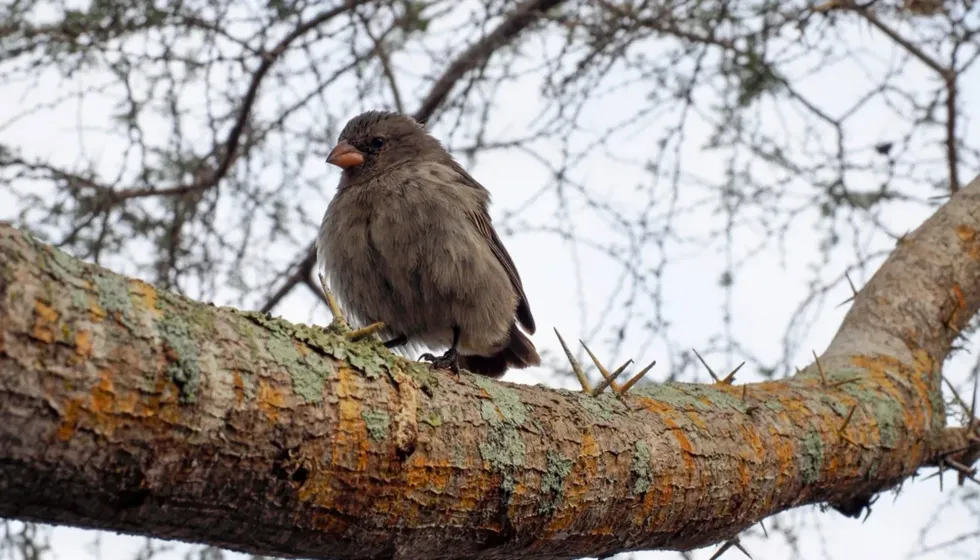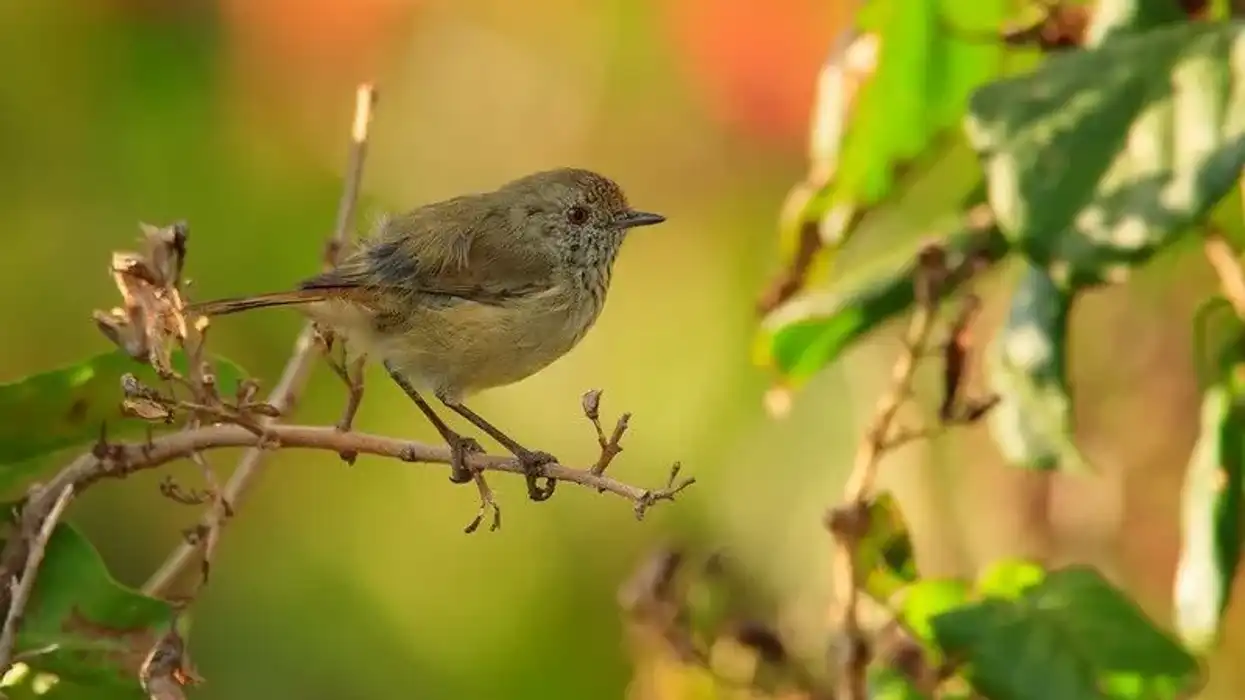Sharp-beaked ground finch (Geospiza difficilis) is a bird species that belong to Darwin's group of the tanager Thraupidae family. This family is the second largest bird family and consists of 12% of neotropical birds and 4% of all avian species.
Jean Cabanis, a German ornithologist, introduced this family in 1847. This family consists of 383 species. John Gould, an English ornithologist, introduced the genus Geospiza, in 1837, along with the large ground finch.
The name of this genus is a derivative of two Greek elements, gê means 'earth' and spíza means 'finch-like birds.' There are nine bird species in this genus.
These birds are a part of the Coerebinae subfamily within this family. These finches are endemic to the Galapagos Islands, Ecuador. The sharp-beaked ground finch is of black and brown color.
Genovesa ground finch and vampire finch are two of the three subspecies of the sharp-beaked ground finch. For decades these bird species were a part of the Emberizidae family with old-world buntings and new-world sparrows.
If these facts about sharp-beaked ground finch were interesting, you might read about the palm warbler facts and the Savannah sparrow facts.
Sharp-Beaked Ground Finch Interesting Facts
What type of animal is a sharp-beaked ground finch?
The endemic species of Galápagos Islands' sharp-beaked ground finch (Geospiza difficilis) is of the order Passeriformes and phylum Chordata. These finch birds form monogamous pairs and small groups. These birds are residents of their natural habitat, but the ones at high altitudes descend after breeding.
What class of animal does a sharp-beaked ground finch belong to?
The sharp-beaked ground finch (Geospiza difficilis) belongs to the class Aves of animals.
How many sharp-beaked ground finches are there in the world?
The exact number of sharp-beaked ground finch (Geospiza difficilis) in the world is unknown.
Where does a sharp-beaked ground finch live?
Sharp-beaked ground finch (Geospiza difficilis) is an endemic species of the range in the Galápagos Islands in Ecuador. In this area, they are found across the islands of Fernandina, Santiago, Genovesa, Pinta, Darwin, and Wolf.
What is a sharp-beaked ground finch's habitat?
Sharp-beaked ground finch habitat range includes highlands of the three large islands, Fernandina, Santiago, and Pinta. The range of terrain of sharp-beaked ground finch includes high elected open areas with vegetation. In the low islands of Darwin and Wolf, they are often found in dry and arid scrublands that have open vegetation.
Who does sharp-beaked ground finches live with?
Sharp-beaked ground finch (Geospiza difficilis) live in the small group and form monogamous pairs during the breeding season.
How long does a sharp-beaked ground finch live?
The sharp-beaked ground finch's (Geospiza difficilis) lifespan is not known. However, the average lifespan of finches is 5-7 years.
How do they reproduce?
Sharp-beaked ground finches' (Geospiza difficilis) reproduction depends on rainfall. Birds in highlands breed in the wet season. They breed in humid highlands and forests in the islands of Fernandina, Pinta, Wolf, and Santiago and descend later to arid zones.
Whereas the Genovesa birds breed after the first rains from January through May. Males whistle, buzz, and sing during courtship. The female lay three clutches per breeding season.
Males build a spherical structured nest that has a lateral entry facing the top. This nest is made of plant materials like dry grass, and the male places it in cactus or bush.
These birds produce 3-4 white eggs with several dark markings. The incubation period is for 12 days. After hatching, the young ones leave the nest 13-15 days later.
What is their conservation status?
The conservation status of sharp-beaked ground finch (Geospiza difficilis) is Least Concern according to the IUCN. However, the conservation status of their subspecies is Vulnerable due to habitat destruction. This species came to terms with their new territory on islands easily.
Sharp-Beaked Ground Finch Fun Facts
What does sharp-beaked ground finches look like?
The overall plumage color for the adult male sharp-beaked ground finch (Geospiza difficilis) is black with slightly brown tails and wings, and also the under tail coverts are white-fringed. They have a straight culmen on the sharply pointed bill. They transition to brown with a yellow tip and orange base during the breeding season.
At the end of the breeding season, they turn yellow-orange. They have dark brown eyes and black legs and feet.
The female has a dark-streaked olive-brown head, upper parts, and throat. They have a grayish-olive scaly pattern on the upper body. They have buff fringes on the dark brown upper wings.
The underbelly is dark brown streaked, which gets darker further down. They have whitish-buff under tail coverts.
The dark tail has gray edges. The bill varies in color according to breeding seasons similar to the male. The juvenile male coloration lies between the black adult male and streaked female.

How cute are they?
These small dark-colored species are considered cute.
How do they communicate?
This species uses calls and body language to communicate. Their voices vary according to the islands like the single note 'ch-rheeeww' or triple 'zheew, zheew.'
On the Genovesa islands, this song is 'tzh-waa' or sometimes a high 'tzeeeww.' The song of the lowland islands has a single structure whereas the forest population song is complex. The song of the species on Darwin is a simple 'trill' and short, multi notes on the Wolf island.
How big is a sharp-beaked ground finch?
The sharp-beaked ground finch length is 4.3-4.7 in (11-12 cm).
How fast can a sharp-beaked ground finch fly?
The flight speed of this bird is not known.
How much does a sharp-beaked ground finch weigh?
The weight of a sharp-beaked ground finch is 0.02-0.04 lb (13-20 g).
What are the male and female names of the species?
There is no specific name given to male and female sharp-beaked ground finches.
What would you call a baby sharp-beaked ground finch?
There is no specific name given the baby sharp-beaked ground finch.
What do they eat?
The competition for food sources of sharp-beaked ground finch (Geospiza difficilis) increases with the presence of different species with the return of the breeding season. A sharp-beaked ground finch's diet includes insects, leaves, flowers, seeds, and cactus pulp.
Their varying beak sizes and shapes allow them to feed on different types of food. The vampire finch (G. septentrionalis) race of the Darwin and Wolf island diet consists of blood from seabirds like a booby. They peck on the growing feathers of the seabirds and lick the flowing blood.
They also feed on the eggs of seabirds by cracking them open against rocks. The ones living high up mostly feed on seeds, forage, and small invertebrates.
Are they poisonous?
No, these birds are not poisonous.
Would they make a good pet?
No, these small birds would not make a good pet.
Did you know...
The subspecies vampire finch or vampire ground finch (Geospiza septentrionalis) is found on the Darwin and Wolf islands. The subspecies Genovesa ground finch (Geospiza acutirostris) is endemic to dry areas in Genovesa islands.
The subspecies vampire finch often drinks the blood of seabirds like the blue-footed booby. Only this species displays this behavior.
Another subspecies G. d. debilirostris is found in Santa Cruz, Fernandina, Santiago, and Isabela in the west and central Galapagos Islands. All these subspecies display different behavior, have different body size range and are different billed. This is a large subspecies.
Darwin's finches, or Galápagos finches, were first described in 1888 by Richard Bowdler Sharpe. They are named after the biologist Charles Darwin.
Darwin's theory suggested that if this species was separated on different islands, it would be easier to keep an account of the population on these islands. There are few accounts of this species being found on volcanic islands.
Predators include cats, dogs, rats, owls, hawks, and snakes. Also, the destruction of the environment is a threat caused to these species by pigs, goats, and tourists.
The vampire finch of the wolf and darwin islands drink blood as a last resort when they can't find their usual food sources like insects or seeds.
How do the bills of tree finches and ground finches differ?
The main difference in the bills of the ground and tree finches is the shape. Tree finches have curved culmen, whereas ground finches have sharp and straight culmen.
Is the sharp-beaked ground finch also known as the vampire bird?
Although the sharp-beaked ground finch's scientific name is Geospiza difficilis and the vampire finch is Geospiza septentrionalis, the sharp-beaked species are known as vampire finches. Due to this is they drink blood from seabirds. They peck on the growing feathers of the seabirds and licks the flowing blood.
Here at Kidadl, we have carefully created lots of interesting family-friendly animal facts for everyone to discover! For more relatable content, check out these hummingbird facts and Amazon parrot facts.
You can even occupy yourself at home by coloring one on our Sharp-Beaked Ground Finch coloring pages.










